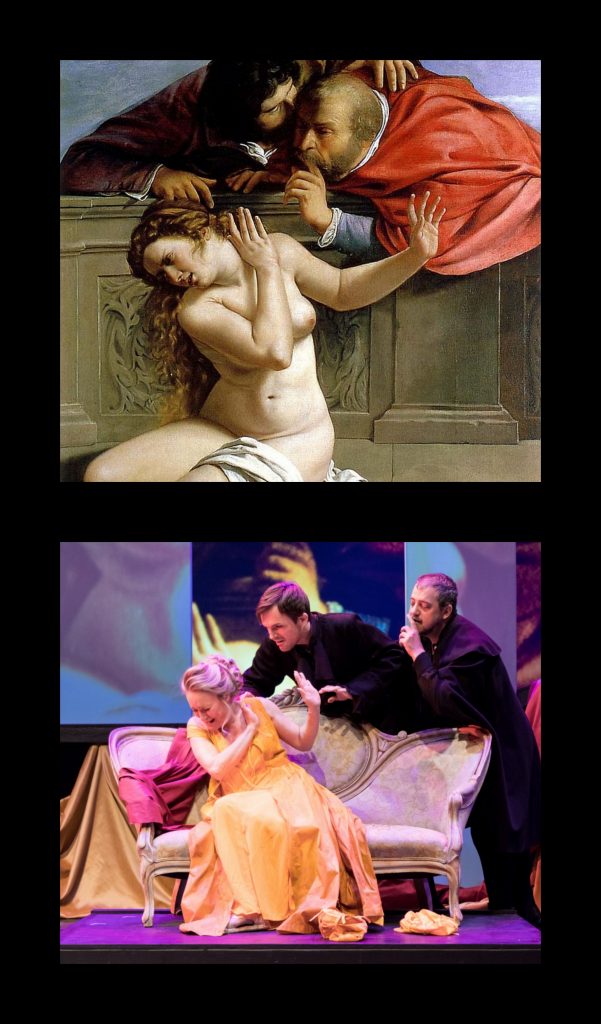Tomorrow 11am Eastern, noon Central, and 6pm GMT, from the National Gallery of Art in London (online, registration req’d), an event with Artemisia‘s composer Laura Schwendinger, librettist Ginger Strand, and Billy Barrett and Ellice Stevens, of Breach:
The artist’s life in performance
Performers, theatre-makers and musicians discuss how they have told Artemisia’s story through opera and theatreAbout
The story of Artemisia Gentileschi’s life is as dramatic as it is remarkable. As a woman making her way in a man’s world, her identity shifted from daughter of the influential artist Orazio and the survivor of abuse, to a canny player of the art market and bravura painter.
Today, Artemisia’s determination to succeed has become a source of inspiration to other artists, whose work in their various forms continue to tell her story.
This event brings together performers, theatre-makers and musicians to share their work made in response to Artemisia and the various ways they empathise with the artist.
Through discussion and excerpts of performances, this event also provides a timely reminder of the power in telling stories on stage in challenging times.
Speakers
Speakers include Billy Barrett and Ellice Stevens, co-founders of multimedia performance company Breach, whose play ‘It’s True, It’s True, It’s True’is a gripping dramatisation of the 1612 rape trial brought by Artemisia.
Also speaking are composer Laura Schwendinger and librettist Ginger Strand, whose opera, ‘Artemisia‘, produced in New York and San Francisco, is a riveting portrayal of the artist’s story.
Both productions will be made available to attendees following the event.
The event is chaired by Amber Massie-Blomfield, whose first book ‘Twenty Theatres to See Before You Die’ received the Society of Authors’ Michael Meyer Award in 2018.

https://www.nytimes.com/2020/10/05/arts/artemisia-gentileschi-national-gallery.html
October 5, 2020
Blood, Passion and Captivity: Gentileschi’s Life Is in Her Paintings
A new blockbuster exhibition at the National Gallery in London shows the artist’s defiant strength, forged in the trials she endured.
By Eleanor Nairne
LONDON — The National Gallery opted for a one-word title for its new blockbuster show: “Artemisia.”
The name of the exhibition, which opened on Saturday and runs through Jan. 24, 2021, has a pop star ring, befitting the most celebrated female artist of the 17th century. In her lifetime, Artemisia Gentileschi was lauded by the artist Jérôme David as “a miracle in painting, more easily envied than imitated”; today, she is the subject of feverish new scholarship, not to mention films, plays, novels and even a cameo in a 2017 children’s book, “Good Night Stories for Rebel Girls.”
But why does first-name familiarity seem to be so often applied to women artists and not men? Kahlo is endlessly referred to as Frida, but only Kanye West takes the liberty of calling Picasso just Pablo.
Perhaps the title is intended to distinguish Gentileschi from her father, Orazio, who was also an esteemed painter. Born in Rome in July 1593, she was 12 when her mother died in childbirth, and she was left in his sole care. Giovanni Baglione’s “Lives of Painters, Sculptors and Architects” (1642) describes Orazio as “more beast than human,” with a “satiric tongue” that “offended everyone.” But at least he was aware of the prodigal talents of his only daughter: When she was 18, he boasted to the Grand Duchess of Tuscany that she was “already capable of such works that many principal masters of this profession never arrive at.”
The National Gallery show is Gentileschi’s first exhibition in Britain, and it proves that her father’s statement sprang from more than parental pride (or a bid for patronage). The 29 paintings on display — just under half of the total works believed to be by her hand — demonstrate her startling emotional sensitivity as she brought a new kind of intimacy to the theatricality of Baroque art.
In 2018, the National Gallery acquired its first work by Gentileschi, “Self Portrait as Saint Catherine of Alexandria,” making her only the eighth female artist in a collection that has work by more than 700 men. The curatorial team recognized the opportunity to stage a major monographic show, which would resonate with the #MeToo movement and help counter the gender imbalance of the collection. The gains would be considerable, but it would be no mean feat: Those who own Gentileschi’s works don’t part with them lightly, several paintings are riddled with conservation challenges, and others are clouded in dispute….
What a lovely departure from economics. Thank you.
Hear!!!! Hear!!!!! What he said.